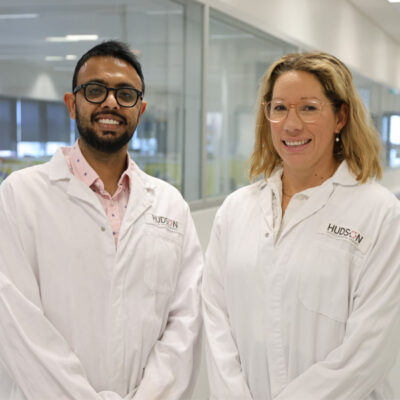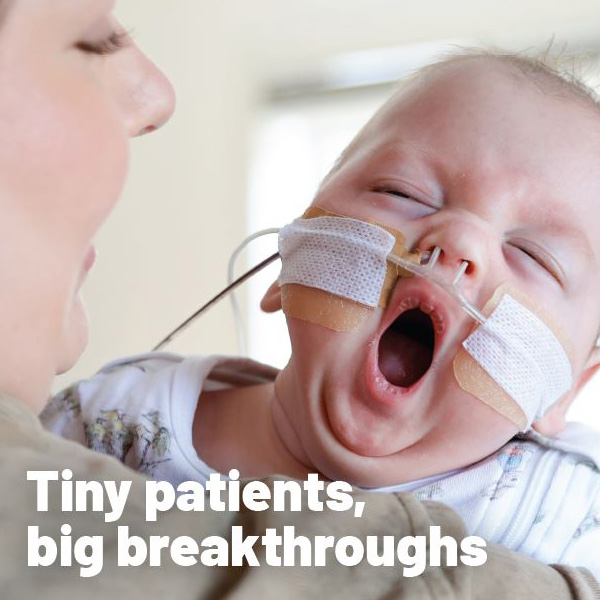Umbilical cord blood could improve brain injury in babies
By Hudson Institute communications. Reviewed by Dr Tayla Penny

New laboratory research shows multiple doses of umbilical cord blood (UCB), rather than a single treatment, could help improve brain injury in babies starved of oxygen during pregnancy or birth.
About cerebral palsy
- Cerebral palsy is an umbrella term that refers to the motor and postural impairments associated with damage to the developing brain. Cerebral palsy can result from injury sustained during pregnancy, at or around the time of birth, or up until one month of age.
- There are about 34,000 people with cerebral palsy (CP) in Australia and about 17 million globally.
- Every 15 hours an infant in Australia is born with a brain injury that underlines CP, making it the most prevalent congenital neurological disorder in our population.
- CP costs Australia more than $1.5 billion per year.
- The largest contributor to cerebral palsy is preterm birth. Up to 70 per cent of these have been complicated with an infection during pregnancy.
- Children with cerebral palsy have difficulty with movement, but also experience a range of other impairments, including difficulty talking, vision, sleeping and behaviour.
Read more about cerebral palsy and our multiple research approaches to this condition here
The study, published in the journal Brain Research could help pave the way for clinical trials to test the treatment in babies. UCB therapy has the potential to improve poor motor and cognitive outcomes in children with cerebral palsy. One in 700 babies in Australia is diagnosed with this condition, which affects muscle tone, movement and motor skills.
Nearly half of all infants treated with the current best-practice therapy of whole-body cooling, to reduce inflammation and interrupt brain injury, will still die or suffer lifelong disability.
First author, PhD student Tayla Penny, said Hudson Institute scientists from the Neurodevelopment and Neuroprotection Research group have previously shown in preclinical studies that stem cells from UCB is a safe and effective treatment for perinatal brain injury (acquired in pregnancy or birth process), when followed up short-term.
“We have demonstrated that a single treatment improves long-term behavioural outcomes, but does not protect the brain from physical injury,” Ms Penny said.
“In this study, we compared the long-term efficacy of a single dose of UCB versus multiple doses. For the first time, we’ve discovered that giving multiple doses of umbilical cord blood stem cells is able to improve behavioural outcomes, but most importantly, also reduces long-term physical injury to the brain.”
Ms Penny said these multiple doses of cell therapies could lead to reductions in the incidence of cerebral palsy.
“In this case, it’s a bit like eating one apple a day – it’s not going to keep the doctor away. While a single dose of umbilical cord blood stem cells may not be effective in the long-term, multiple doses over time could protect the brain from long-term damage”
Stem cell therapies research
Ms Penny’s research explores stem cell therapies as a treatment for babies deprived of oxygen during pregnancy or birth. This can cause long-term motor impairment and poor neurological outcomes, which can lead to conditions such as cerebral palsy.
“Current therapies available for these babies are often ineffective and are only appropriate for babies born at term, with no other existing conditions. Because of this, it is important that we develop new treatments for babies who are oxygen deprived. For this, we are turning to stem cells derived from umbilical cord blood (UCB).”
Next steps
Ms Penny said the study will be used to inform the group’s future clinical trials using UCB as a therapy in oxygen-starved babies. “Until now most clinical trials have only administered a single dose of cells. Given our results, we are designing new trials with clinicians to include multiple doses.”
About stem cells and stem cell therapies
The human body is made up of more than 200 different kinds of specialised cells, such as muscle, nerve, fat and skin cells. All specialised cells originate from stem cells. Stem cells are different from other cells in the body in two main ways. They can
- Make copies of themselves, or self-renew
- Differentiate or develop into specialised cells
- Stem cells are found in bone marrow, blood or umbilical cord blood, in blood vessels, skeletal muscles, skin and the liver.
Stem cell therapy is a treatment using stem cells to replace or repair a patient’s damaged cells or tissues. Umbilical cord blood is a rich source of stem cells that can be used in research and in the clinic to treat diseases of the blood and immune system.
Collaborators | Monash Health, Monash University
This research was supported by | Inner Wheel Australia
In this article
About Hudson Institute
Hudson Institute’ s research programs deliver in three areas of medical need – inflammation, cancer, women’s and newborn health. More
Hudson News
Get the inside view on discoveries and patient stories
“Thank you Hudson Institute researchers. Your work brings such hope to all women with ovarian cancer knowing that potentially women in the future won't have to go through what we have!”






